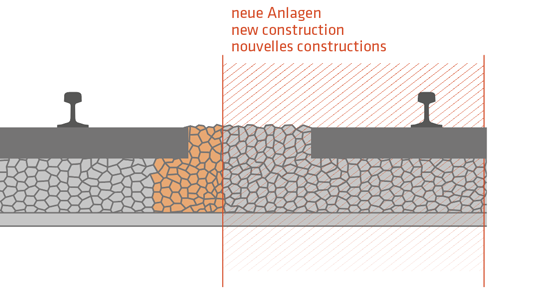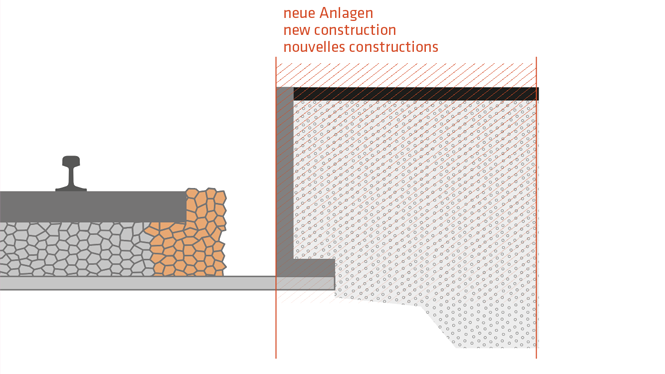Temporary ballast retainers
Using innovative ballast bonding instead of conventional bracing can save a great amount of time and money.
When replacing an adjacent track or creating drainage routes or new platform edges, the bonded ballast replaces conventional construction methods.
By automatically bonding the ‘ballast shoulder’ in a perfectly even and controlled manner, even exposed operational tracks can support traffic at speeds of up to 80 km/h.
Thanks to our reliable bonding technology, we are the only company that is approved with the necessary clearance to drive on exposed tracks.
This makes it possible to perform construction works faster and more cost effectively with fewer track-traffic stoppages.
The loud and lengthy ramming work associated with conventional ballast bracing can be dispensed with entirely. Especially near train stations, which are usually in residential areas, night noise is an important factor, which needs to be avoided.
Application case

Replacing drainage pipes on the railway embankment
To replace pipes in the edge area of the ballast bed, the entire ballast in front of the sleeper head can be reinforced. This allows the replacement works to be carried out more quickly while ensuring the stability of the ballast bed against sliding or lateral movements.

Replacing drainage pipes between the tracks
For the replacement of pipes between two tracks, the ballast is reinforced in both edge areas in front of the sleeper head. This allows the replacement works to be carried out more quickly while ensuring the stability of the ballast bed against sliding or lateral movements.

Replacing ballast on neighbouring rail tracks
For the complete replacement of the ballast bed in the siding of a railway track, a rectangular cross-section is temporarily bonded to the operating track in order to carry out quick and precise construction work while ensuring the stability of the operating track against sliding or lateral movements.

Securing track ballast to build platform angles
For civil engineering works on station platforms, a rectangular cross-section is temporarily bonded in the secondary area of the ballast bed in order to create space for the civil engineering works and to accelerate it while ensuring the stability of the ballast bed against sliding or lateral movements.

Replacing cable ducts
To replace cable ducts in the edge area of the ballast bed, the entire ballast in front of the sleeper head is reinforced. This allows the exchange work to be carried out more quickly while ensuring the stability of the ballast bed against sliding or lateral movements.